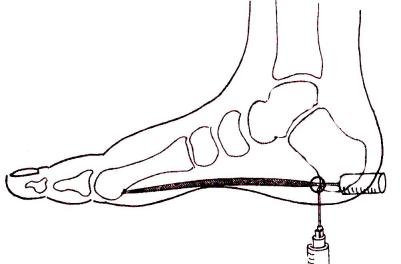
Cortisone Injections
Synopsis
Cortisone is a type of steroid that is produced naturally by a gland in your
body called the adrenal gland. Cortisone is released from the adrenal gland when
your body is under stress. Natural cortisone is released into the blood stream
and is relatively short-acting. Injectible cortisone is synthetically produced
and has many different trade names (e.g. Celestone, Kenalog, etc.), but is a
close derivative of your body's own product. The most significant differences
are that synthetic cortisone is not injected into the blood stream, but into a
particular area of inflammation. Also, the synthetic cortisone is designed to
act more potently and for a longer period of time (days instead of minutes).
Many conditions where inflammation is an underlying problem are amenable to
cortisone shots. These include, but are certainly not limited to
The shot can be slightly painful, especially when given into a joint, but in
skilled hands it usually is well tolerated. Often the cortisone injection can be
performed with a very small needle that causes little discomfort. However,
sometimes a slightly larger needle must be used, especially if your physician is
attempting to removed fluid through the needle prior to injecting the cortisone.
Numbing medication, such as Lidocaine or Marcaine, is often injected with the
cortisone to provide temporary relief of the affected area. Also, topical
anesthetics can help numb the skin in an area being injected.
Typical Injection sites for the foot.
Side Effects
Probably the most common side-effect is a 'cortisone flare,' a condition where
the injected cortisone crystallizes and can cause a brief period of pain worse
than before the shot. This usually lasts a day or two and is best treated by
icing the injected area. Another common side-effect is whitening of the skin
where the injection is given. This is only a concern in people with darker skin,
and is not harmful, but patients should be aware of this.
Other side-effects of cortisone injections, although rare, can be quite serious. The most concerning is infection, especially if the injection is given into a joint. The best prevention is careful injection technique, with sterilization of the skin using iodine and/or alcohol. Also, patients with diabetes may have a transient increase in their blood sugar which they should watch for closely.
Because cortisone is a naturally occurring substance, true allergic responses to the injected substance do not occur. However, it is possible to be allergic to other aspects of the injection, most commonly the betadine many physicians use to sterilize the skin.
Recurrent Treatments
There is no rule as to how many cortisone injections can be given. Often
physicians do not want to give more than three, but there is not really a
specific limit to the number of shots. However, there are some practical limitations.
If a cortisone injection wears off quickly or does not help the problem, then
repeating it may not be worthwhile. Also, animal studies have shown effects of
weakening of tendons and softening of cartilage with cortisone injections.
Repeated cortisone injections multiply these effects and increase the risk of
potential problems. This is the reason many physicians limit the number of
injections they offer to a patient.